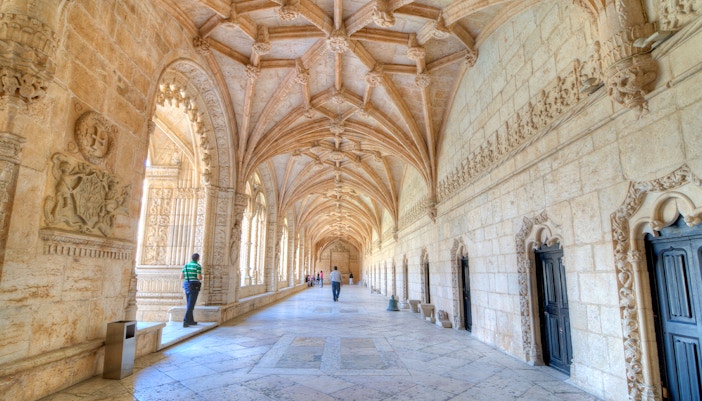Popularly known as Portuguese late Gothic architecture, this was one of the artworks that resulted from the transition during the age of the Renaissance. One of the striking features of this style of architecture is decorative paneling on windows, arcades, and pillars. The inlays on the stonework are intricately made, displaying complete craftsmanship. The Jerónimos monastery was designed by the influential architects Diogo Boitac and João de Castilho in Portuguese history.
12 Jerónimos Monastery facts you shouldn't miss

1. A showcase of the rare Manueline architecture

2. It's one of Portugal's Seven Wonders
If you are visiting Portugal, you may not want to miss the Jerónimos Monastery, which is named one of the seven wonders of the coastal nation. Not just this, there is an added advantage of visiting the place. You can also visit another one of Portugal's Seven Wonders, the Belem Tower. Built during 1514-1520 AD, the tower is located a few minutes walk from the monastery.

3. Dedicated to Virgin Mary
As Portugal is a coastal country, the sailors frequented their navigation to and from the Belem. Hence, for the safety of voyagers who undertook navigation and made great advancements for Portugal, the monastery was consecrated. It was believed that it was the blessing of the Virgin Mary that made the voyage of famous explorer Vasco Da Gama and other sailors possible. Hence, the construction of Jerónimos Monastery was ordered in the year 1496.

4. Named after Saint Jerome
The Jerónimo Monastery, also known as the Hieronymites Monastery, is named after St. Jerome, a Christian priest, theologian and historian who was one of the most learned scholars of the early Christian Church and is best known for his translation of the Bible into Latin, the "Vulgate". The name "Jerónimo" is the Spanish form of "Jerome".

5. Home to monks
The Jerónimos monastery was earlier home to monks belonging to the Order of Saint Jerome. The main task of all the monks who resided in the monastery was to conduct spiritual discourse and pray for the welfare of the sailors and the King, along with his family members. Even though the system was ended in 1833, it is still one of those spaces with echoes of silent meditations, prayer, and spiritual orders from the monks residing at the monastery.

6. Birthplace of the Pastel de Nata
Pastel de Nata is one of the Portuguese custard tarts that was invented in Jerónimos monastery. It is believed that the monks who resided at the Jerónimos monastery used egg white to starch their white clothes. However, they did not let the egg yolk go to waste, and hence the yummiest pleasure of Pastel de Nata was discovered here. Even though the dessert has become quite famous now, the excitement to have this one served right to you in the place of its origin is beyond description!

7. Symbol of the Age of Discovery
The Portuguese-Gothic architecture was built around the time when Europe was witnessing a humongous change in art, science, philosophies, technologies, and other related fields. Additionally, it symbolizes the great wealth, power, and resource of the Portuguese country during the age. The Manueline architecture is a homage to the era of discovery during which the Jerónimos monastery was built.

8. Burial site of National icons
The monastery is now the resting place of some of the members of the ruling class and their families. King Manuel I, along with the family members, were laid to rest here. Besides, one of the famous sailors and explorers of all times who opened the trade route to India, Vasco da Gama, is buried here. His remain from St. Francis CSI Church of Kochi in India was initially transferred to the monastery of Nossa Senhora das Relíquias and later to Jerónimos monastery.

9. Hosts a Thai Pavilion in Lisbon
To commemorate the eventful day of the Portuguese arrival in Thailand and mark the 500 years of the friendly journey together, a Thai pavilion/ Sala Thai, built-in Bangkok was sent to Jerónimos monastery. The pavilion is 22 feet high and ornamented in a red and golden structure. The roof of the pavilion resembles the skin of a dragon that is famous in other Thai architecture too.

10. Recognized as a UNESCO World Heritage Site
Jerónimos Monastery is named one of the UNESCO World Heritage Sites and draws millions of tourists from around the world. The world organization declared this in 1983, along with the Tower of Belem. Besides, it is one of the most frequented sites in the world, and Portugal, in general, is known for its mesmerizing architecture, spaces, lawns, and grand fountain. It was declared the national monument of Portugal in 1907 and is on the bucket list of tourists traveling to the country.

11. The walls are masterpieces themselves
The columns of the wall have been intricately carved with utmost attention to the designs of any creature, floral art, etc. The hanging gargoyles on the top and minute paneling and design on the walls are something to look forward to. The Jerónimos Monastery is 300 meters long and has a beautifully decorated facade. One of the major paintings that you will find across the monument is from the life of St. Jerome. This includes: O Penitente no deserto(Penitent in desert), O Doutor da Igreja(Doctor in the church), and O Estudioso na sua cela (The Studious in the Cell).

12. Construction took more than 100 years
It took the sculptors and architects more than 100 years to build the monastery in its entirety. The architecture has stood strong for generations now. The great Earthquake of 1755 left some changes in the monument that was built way back. Even today, the architecture of the monastery is seen as one of the finest and most well-built places in the world.




